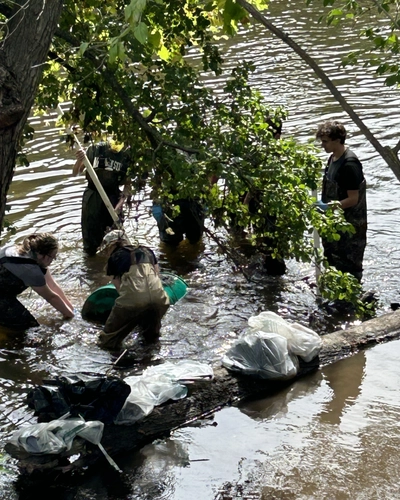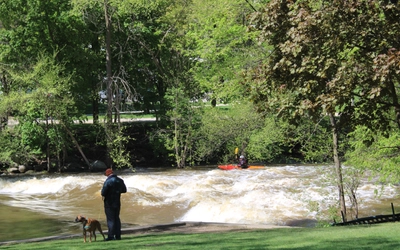Running through the heart of Michigan State University’s campus, the Red Cedar River has long served as a beacon of recreation, teaching and learning, and a thriving ecosystem for the campus community. If you ask a current Spartan or alum what the river means to them, it’s likely no two responses will be the same. The common thread is that the river provides something for everyone. And in order for everyone to benefit from this natural campus resource, it truly takes a village.
River revitalization
For the past 18 months, MSU’s Manager of Landscape Services Matt Bailey has been dedicated to keeping the river clean, enhancing its ecosystem and expanding its overall functionality. Each year, MSU Infrastructure Planning and Facilities hosts two river cleanup days that bring together volunteers from MSU and the surrounding community — including student groups — who spend the days working hands-on in and around the river to help restore and revitalize this important campus asset. Those efforts include removing debris including garbage, scooters, car batteries, bikes, other pollutants as well as invasive species of plants.
“I have learned that there are a lot of people that are interested in the Red Cedar River,” said Bailey. Students, faculty, staff, surrounding community members including families and environmental groups all appreciate the work we’re doing and look forward to that positive momentum continuing in the months and years to come.”
Bailey is part of the Red Cedar River Stewardship and Recreation Committee, an organization composed of 24 MSU employees spanning 16 university administrative units that strives to ensure MSU is actively engaged in the long-term health of the Red Cedar River while providing a variety of educational, research and recreational opportunities on and near campus.
John Paskus, a teaching specialist in the Department of Community Sustainability in the College of Agriculture and Natural Resources, serves as co-chair of the committee.
“It’s one of the places you can go to and connect with nature and feel that sense of connection,” said Paskus. “It’s that natural oasis that you really can’t find any other place in this area and is truly a special campus asset that we hope will have the same level of reverence and respect as the Sparty statue and Beaumont Tower in the near future.”
In addition to the remediation work that has been underway, several recreational improvements have allowed for more opportunities for the Spartan and surrounding community to enjoy all the river has to offer.
Expanded recreational opportunities
In April 2025, the MSU Board of Trustees authorized a revision to the university’s wildlife ordinance, which expands fishing opportunities to students, faculty, staff and the public. The previous ordinance, established in the 1960s, banned hunting, fishing and gathering on campus due to its designation as a wildlife preserve.
“I have seen a lot more fishing lines being cast since the board revised their ordinance,” said Bailey. “With more than 30 species of fish found in the river, no two catches will be the same.”
The decision was driven by community support and the university’s goal to promote environmental stewardship and community engagement. Under the revised ordinance, a current fishing license is required from the Michigan Department of Natural Resources and only catch and release fishing is permitted.
If casting a line isn’t your thing, perhaps a light workout paddling down the river is. In May 2024, the university, in partnership with the East Lansing Rotary Club, installed a new seasonal kayak/canoe launch near Jenison Field House using what’s called a “Mobi-Mat” — a safer, more accessible option for getting in and out of the river. IPF Landscape Services also installed a safe portage landing for boat traffic to navigate downstream past the weir, just south of the Hannah Administration Building. There are plans to install an interpretive kiosk at the location that will help to educate the community about the history and ecology of the river.
Efforts are also underway to create an official water trail from Williamston to the confluence of the Grand River—serving as a unified vision for the surrounding communities and organizations to rally around.
Community green spaces
Clippert Park is at the southeast corner of Kalamazoo Street and Clippert Street and is owned by MSU on the south side and by the city of Lansing on the north side of the river. The area was overgrown with invasive plants, until recently, when MSU and other community partners worked together to clear the space. This fall, MSU, in partnership with the city of Lansing, plans to further enhance the green space with pollinator seeding, signage for fishing, picnic tables and walking trails.
Looking forward
While this is not a complete list of improvements and ongoing modifications planned to revitalize spaces in and around the Red Cedar, additional information about river stewardship is available on MSU’s Office of Sustainability and IPF websites. Questions, comments or concerns about the Red Cedar River can be directed to Matt Bailey or John Paskus.
The next river cleanup is scheduled for Oct. 18.



